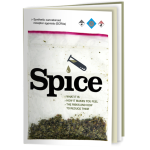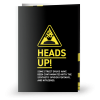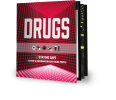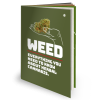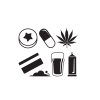What is spice?
Spice is a mixture of chemicals created in a lab to mimic the effects of cannabis. It’s the most common synthetic cannabis and is known by various names including fake cannabis, K2, black mamba and lots more, depending on where you live.What does it look like?
The chemicals in spice, known as synthetic cannabinoid receptor agonists (SCRAs), start off as a powder, are turned into liquid and then usually sprayed onto chopped-up leaves and herbs to look like herbal cannabis (unlike cannabis, spice isn‘t sticky, doesn’t contain buds and has no distinctive smell). These chemicals can also be sprayed onto paper, making spice much harder to detect, and it’s in this form that it often finds its way into prisons.
How is it used?
Spice is usually mixed with tobacco and smoked like cannabis to make the most of its similar effects. More and more, it’s turning up in vapes and e-liquids, often sold online as CBD or THC liquids.
How strong is spice?
There are hundreds of different SCRAs, and they vary in strength and toxicity. There’s no consistency. It all depends on the type and amount of SCRAs used in each batch. So, there’s no way of knowing how strong your spice is going to be, or how it’ll affect you. Spice is potent even at very low doses: a pinch the size of a match head is an active dose.
Is spice illegal?
Spice is an illegal class B drug, the same as cannabis. It‘s illegal to make, sell, or possess. It used to be a legal high, until the law changed in 2013. Some synthetic cannabinoids are altered to avoid the class B classification and come under the new Psychoactive Substances Act 2016. Under this Act, possession for personal use is not an offence but production and dealing are illegal.
But, it’s an offence to possess, supply, or produce psychoactive substances in prison. Some synthetic cannabis can already be detected in urine tests, and more tests are being developed.
How does spice make you feel?
Spice can make you feel euphoric, relaxed, happy, talkative and drowsy. The effects are felt in seconds and typically peak in half an hour or so and tail off over the next two to three hours.
Can you overdose on spice?
Using too much spice is easy because an active dose is so small, and you can‘t be sure which chemicals have been used and what effect they’ll have on you.
Symptoms of overdose can range from the mild to the severe.
Mild
- Anxiety
- Paranoia
- Nausea
- Vomiting
Severe
- Inability to move
- Seizures
- Convulsions
- Psychotic episodes
- Abnormally fast heartbeat
- Hallucinations
Is spice addictive?
Regular use of spice can lead to dependence (addiction) and withdrawal.
Withdrawal symptoms include the following:
- Disturbed sleep
- Profuse sweating
- Irritability Cravings
- Tremors Seizures
Tolerance
Tolerance to spice can build up quickly, sometimes within just a few days of regular use. Tolerance means your body gets used to the effects of spice and you need to use more to get the same effects. Because the chemicals in spice change so often, even experienced users who’ve built up a tolerance to its most extreme effects, can get those extreme effects again with any new batch.
Reducing the risks
There‘s no safe way to use spice. If you use it, there’s a risk of harm. But, if what you’ve read so far hasn’t put you off, there are certain things you can do which may help reduce the risks.
Low and slow
Use a small amount, about the size of a match head, or less, and wait to see how it affects you before considering using more.
Avoid other drugs, alcohol or medicines
There are so many types of spice that you can never be sure how it‘ll react with other substances.
Don’t use it on your own
There‘s safety in numbers. You can look after each other.
Look after your mental health
Spice will make existing mental health problems worse. Even small amounts can cause severe mental health side effects in people without a history of mental health problems.
Take a break
You can become dependent. Don‘t use everyday. Get support If you think you‘re dependent, don‘t stop immediately. Use less, and get help and support from your local drug and alcohol service or GP.
Don’t share
Avoid sharing joints, bongs and vapes. Sharing spreads germs.
Sit down
Sit down to prevent falls, tripping, or collapsing.
In an emergency
Someone who’s used spice, might be behaving in a disturbing or worrying way. This can include appearing ‘zombie-like‘, talking gibberisah, hallucinating, and being unable to control movements.
Most of the time this behaviour will pass after a few minutes, but if you’re concerned, roll them on their side, put them in the recovery position and call an ambulance immediately.
Let the emergency workers know what they‘ve taken - it could save their life.
Symptoms include the following:
Heavy, rapid, or shallow breathing
If this goes on for five minutes or longer, call an ambulance.
Overheating
If someone has a high temperature loosen their clothing and put a damp cloth on their forehead. If it doesn‘t drop within five minutes, call an ambulance.
Chest pain or seizures
Try to calm them down, but don‘t delay, call an ambulance.
Bad trip
Reassure them, take them somewhere quiet. No need for an ambulance. It should pass.
Help & support
FRANK
Information about drugs Find out everything you need to know about drugs, their effects and the law. Talk to Frank for facts, support and advice on drugs and alcohol today.
www.talktofrank.com
Call: 0300 123 66 00
ADFAM
Help for the families of drug users Adfam has local groups for families affected by drugs and alcohol. It also has a range of information for the families of drug users.
www.adfam.org.uk
RELEASE
Drugs & the law Release provides free, non-judgmental, specialist advice and information to the public and professionals on issues related to drug use and to drug laws.
www.release.org.uk
Call: 020 7324 2989
